
The rainbow trout is a poisson that fascinates anglers the world over. Both beautiful and combative, this salmonid, recognisable by its pink glints, offers anglers an experience rich in adrenalin and emotion. In this article, we'd like to introduce you to the rainbow trout in great detail. From its physical characteristics to the fishing techniques you can use to catch it.Discover everything there is to know about rainbow trout.
Our article in brief
The rainbow trout is a salmonid that lives in the rivers of Europe and America. It is a fish that is as magnificent as it is wary and sporty.
- Features The rainbow trout is native to North America. Its average size is 20 to 60 cmfor 1 to 5 kg
- Habitat The rainbow trout lives in the cold, oxygenated rivers, streams and lakes of our region.
- Fishing techniques You can fish for rainbow trout with lures, flies or natural baits (worms, moths, grasshoppers, etc.).
Characteristics and origin of the rainbow trout
TheOncorhynchus mykissThe rainbow trout is a salmonid species native to North America. Introduced to Europe in the 19th century, it has adapted perfectly to our waters. The rainbow trout has a silvery coat, dotted with black spots and adorned with an iridescent pink stripe down its sides. These special characteristics give it its evocative name.
Its size generally varies between 20 and 60 cm. However, some specimens can reach the mythical metre mark when conditions allow. Its weight varies between 1 and 5 kg on average.
The following table summarises the main characteristics of the rainbow trout:
| Features | Description |
|---|---|
| Scientific name | Oncorhynchus mykiss |
| Medium size | 20 to 60 cm |
| Average weight | 1 to 5 kg |
| Distinctive colour | Iridescent pink stripe on flanks |
| Longevity | 6 to 8 years |
Although its European cousin, the trout farioThe rainbow trout, which is also a great fighter, stands out in particular for its combativeness. We were often surprised by the power of their rushes and spectacular jumps out of the water during fights.

Habitat and behaviour of rainbow trout
The rainbow trout, like the fario trout, thrives in cold, well-oxygenated waters. It is mainly found in :
- Fast-flowing rivers
- Mountain streams
- High altitude lakes
- Certain landscaped lakes
Rainbow trout are particularly fond of areas with moderate currents and plenty of hiding places. They often position themselves behind rocks or in pools, watching out for passing fish, insects or invertebrates.
The rainbow trout has a fairly varied diet. It feeds mainly on :
- Aquatic and terrestrial insects
- Small fish
- Shellfish
- Of worms

This dietary diversity makes it a highly opportunistic fish, which explains its incredible adaptability when it was introduced to Europe in the 1st century.
As with the brown trout, the rainbow trout is generally most active at dawn and dusk. These are therefore the best times to try your luck at fishing.
How do you fish for rainbow trout?
Fishing techniques for rainbow trout are no different from those used for its fario cousin. Here are the main techniques:
Lure fishing
Fishing for rainbow trout with lures is our preferred technique. We fish very regularly with jerkbaits or crankbaits Smaller lures to explore currents. If we want to fish in hollows, we use soft lures such as shads. If the trout are more attracted to flats or shallow areas, we don't hesitate to use small spinners.
Click here for a detailed article on best trout lures which we recommend you take with you to the water's edge.

Fly fishing
Fly fishing is a classic but formidable technique. Imitations of dry insects or nymphs often produce spectacular results, especially during the hatching period.
Fishing with natural bait
Fishing with natural bait is a rudimentary but highly effective technique. It's also a great way for beginners to start trout fishing. In fact, it was with toc that we began our introduction to trout fishing nearly 30 years ago. river trout fishing.
This initiation at a very young age has enabled us to acquire a very discreet approach as well as a good understanding of the watercourse. A precise cast in a shaded area, in the right stream or behind an obstacle can make all the difference with this fish.
Let's not forget the importance of the right equipment for trout fishing with natural baits. A light 7 to 8 foot rod, coupled with a reel fitted with a 14 to 18 hundredths line, offers an excellent compromise between sensitivity and power to master the rushes of this combative fish.
Conservation and sustainable management of rainbow trout
As fishing enthusiasts, we are aware of the importance of preserving trout populations. Of course, not everyone does, at least not consciously. Although this species is often introduced for restocking, it is necessary to maintain an ecological balance in our waterways.

Here are some actions we recommend for responsible fishing:
- Respect the legal catch sizes
- Practice catch and release when possible
- Use barbless hooks
- Do not fish during spawning periods
The rainbow trout, with its fighting spirit and beauty, embodies the very spirit of freshwater sport fishing.
Let's never forget that the real pleasure of fishing lies as much in the catch as in respecting the fish, and that it takes two to tango.




